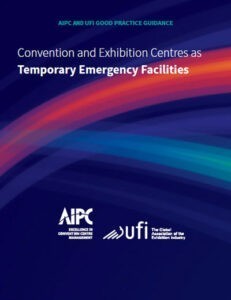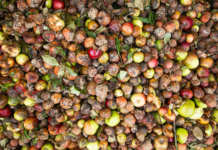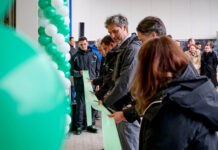In India, extensive facilities such as NESCO, the Bombay Exhibition Centre in Goregaon are being transformed into vaccination centers just as they have been worldwide. The BEC was also used to temporarily house 10,000 migrant workers at the beginning of the Covid-19 induced lockdown last year. Media Expo Mumbai, scheduled to take place at the NESCO in March, has been rescheduled for May. Its organizers, Messe Frankfurt India, are hoping “that with the start of vaccination drives and gradual scaling back of lockdown, we also see confidence returning in the market, and Media Expo will act as a catalyst in the recovery of trade momentum for this sector.” Whether NESCO will be available for trade fairs by that time remains to be seen, given the substantial logistical implications of the vaccine set-up there as much as elsewhere.
When the Covid-19 pandemic started to get out of hand last year, one major trade fair after the other had to be canceled, leaving the world’s exhibition grounds deserted, turning some of these into emergency hospitals for Covid patients. Many of these facilities are still being kept on stand-by or converted into testing or vaccination centers.
ExCel – London
One of the first exhibition grounds to be entirely requisitioned for medical purposes was London’s ExCel. The British Army installed 4,000 hospital beds at the height of the pandemic’s first wave hitting the UK. Soon after, Birmingham’s NEC was to follow with another 4,000 beds. Both are now part of England’s National Health Service Nightingale network of seven exhibition grounds, stadiums, and convention centers converted into emergency field hospitals. Most of these facilities are currently not in use, but they are maintained and kept on stand-by.
Javits Convention Center – New York
One of the first exhibition grounds to be turned into an emergency hospital in the US was the Javits Convention Center in New York. In the heart of Manhattan’s ‘Hell’s Kitchen’ neighborhood, the Center used to be Book Expo America’s main venue. Installed by the US Army Corps of Engineers, the Center’s 2,910 beds remain useful to relieve the city’s hospitals from non-Covid and convalescent patients.
In addition to smaller facilities for testing and hospitalization under tents, such as the one in New York’s Central Park, the Army Corps installed medical facilities in other exhibition and convention centers capable of accomodating hundreds or thousands of hospital beds. A typical example is the Wisconsin State Fair Park and Expo Center, serving as a stand-by hospitalization facility for deployment in the country’s vaccination campaign.

Messe Wien – Vienna
In Europe, Messe Wien, conveniently located in Vienna’s city center, was the first trade fair center to be converted into a medical facility with 2,240 beds back in March last year. Currently, it serves as Austria’s largest Covid-19 testing facility. Fiera Milano, one of the world’s largest fairgrounds, followed by turning two of its exhibition pavilions into an emergency hospital to relieve the hospitals in the Milan and Lombardia region.
UFI, the Global Association of the Exhibition Industry, quickly responded with a good practice guide for ‘Convention and Exhibition Centres as Temporary Emergency Facilities’ updated regularly.
Brussels Expo – Brussels

Brussels Expo, which is to host Label Expo in September this year, still had high hopes, a few months ago, that it could open its doors for one of Europe’s largest car shows in January. The show was canceled, but Brussels Expo’s senior management invested heavily in a unique UV-C disinfection system installed in all of its exhibition and concert halls, conference rooms, and working spaces. In October last year, one of its halls was turned into a Covid-19 test center. Another hall, the largest, is currently being prepared to become Belgium’s largest vaccination center, opening its doors from 15 February.
IndiFoodBev — authentic, impactful and influential
An English-language food and beverage processing and packaging industry B2B platform in print and web, IndiFoodBev is in its third year of publication. It is said that the Indian food and beverage industries represent approximately US$ 900 billion in revenues which implies more than 20% of the country’s GDP. Eliminating the wastage on the farmside can help to deliver more protein to a higher number of the population apart from generating sizable exports. The savings in soil, seeds, water, fertilizer, energy and ultimately food and nutrition could be the most immense contribution that country is poised to make to the moderation of climate change.
To improve your marketing and grow sales to the food and beverage processing and packaging industry, talk to us. Our research and consulting company IppStar [www.ippstar.org] can assess your potential and addressable markets in light of the competition. We can discuss marketing, communication, and sales strategies for market entry and growth.
Suppliers and service providers with a strategy and budget for targeted marketing can discuss using our hybrid print, web, video, and social media channels to create brand recognition linked to market relevance. Our technical writers are ready to meet you and your customers for content.
The second largest producer of fruit and vegetables in the world is continuously expanding processing capacities and delivery systems with appropriate innovative technologies. We cover product and consumer trends, nutrition, processing, research, equipment and packaging from farm to thali. Get our 2025 media kit and recalibrate your role in this dynamic market. Enhance your visibility and relevance to existing markets and turn potential customers into conversations. Ask for a sample copy of our bi-monthly in print or our weekly IndiFoodBev eZine each Wednesday.
For editorial info@ippgroup.in — for advertisement ads1@ippgroup.in and for subscriptions subscription@ippgroup.in
Naresh Khanna – 10 February 2025
Subscribe Now











